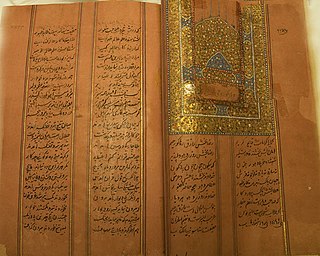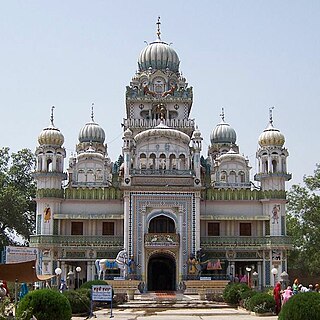
Guru Gobind Singh (22 December 1666 – 7 October 1708), born Gobind Rai, was the tenth Sikh Guru, a spiritual master, warrior, poet and philosopher. When his father, Guru Tegh Bahadur, was beheaded for refusing to convert to Islam, Guru Gobind Rai was formally installed as the leader of the of the gurus followers at age nine, becoming the tenth Sikh Guru. His four sons died during his lifetime – two in battle, two executed by the Mughal army.

The Dasam Granth, also called the Dasven Pādśāh kā Graṅth,, is a holy book in Sikhism with compositions attributed to Guru Gobind Singh. It is a controversial religious text considered to be the second scripture by some Sikhs, and of disputed authority by other Sikhs. The standard edition of the text contains 1,428 pages with 17,293 verses in 18 sections. These are set in the form of hymns and poems mostly in the Braj language, with some parts in Avadhi, Punjabi, Hindi and Persian. The script is almost entirely the Gurmukhi script except for the letter of the Sikh Guru to Aurangzeb – Zafarnama, and the Hikayat in the Persian alphabet.

The Zafarnāma was a spiritual victory letter sent by Guru Gobind Singh in 1705 to the Mughal Emperor of India, Aurangzeb after the Battle of Chamkaur. The letter is written in Persian verse.

Anandpur Sahib, sometimes referred to simply as Anandpur, is a city in Rupnagar district (Ropar), on the edge of Shivalik Hills, Indian state of Punjab. Located near the Sutlej River, the city is one of the most sacred places in Sikhism, being the place where the last two Sikh Gurus lived, Guru Teg Bahadur Ji and Guru Gobind Singh Ji. this is the place where Guru Gobind Singh Ji founded the Khalsa Panth in 1699. The city is home to Kesgarh Sahib Gurdwara, one of the five Takhts in Sikhism.
The Takht Sri Darbar Sahib Damdama Sahib, one of the five Takhts or Seat of Temporal Authority of Sikhism, Takht Sri Damdama Sahib is in Bathinda in Punjab, India and is the place where Guru Gobind Singh, the tenth Sikh Guru, prepared the full version of the Sikh scriptures called Sri Guru Granth Sahib in 1705. The other four Takhts are the Akal Takht, Takht Sri Keshgarh Sahib, Takht Sri Patna Sahib and Takht Sri Huzur or hazur Sahib.
Bhai Dharam Singh (1666–1708), one of the Panj Pyare or the Five Beloved, the forerunners of Khalsa, came of farming stock. He was the son of Bhai Sant Ram and Mai Sabho into Hindu Jat family, of the village Saifpur-Karamchandpur, Hastinapur, Meerut District.

Bhai Mani Singh was an 18th-century Sikh scholar and martyr. He was a childhood companion of Guru Gobind Singh and took the vows of Sikhism when the Guru inaugurated the Khalsa in March 1699. Soon after that, the Guru sent him to Amritsar to take charge of Harmandir Sahib, which had been without a custodian since 1696. He took control and steered the course of Sikh destiny at a critical stage in Sikh history.
Bhai Sahib Singh was one of the Panj Pyare. He was formerly known as Sahib Chand and was a Barber (Nai) before being baptized into Khalsa tradition.
Mata Sahib Kaur was the third wife of Guru Gobind Singh. Born Sahib Devan, she was the daughter of Ramu of Rohtas dist. Jhelum. Mata Sahib Kaur was born on 1 November 1681 at Rohtas. She was offered to be a bride of Guru Gobind Singh by her father Bhai Rama, a devout Nanak Naam Leva Sikh, and the nuptials took place on 15 April 1700 at Anandpur.
Sahibzada Fateh Singh Ji was the fourth and youngest son of Guru Gobind Singh. He and his older brother, Sahibzada Zorawar Singh are among the most hallowed martyrs in Sikhism. He is also known as Baba Fateh Singh. The term Baba is used in India for an elder who is respected for his wisdom.
Zafarnama is the title of a number of Persian and Turkish literary works by Atul Saini

Mai Bhago also known as Mata Bhag Kaur, was a Sikh woman who led Sikh soldiers against the Mughals in 1705. She was an exceptionally skilled warrior on the battlefield and is revered as a saint in Sikhism. She was known for rallying the 40 Sikhs who abandoned Guru Gobind Singh at the siege of Anandpur Sahib and bringing them back to fight.
Chhotte Sahibzade of Guru Gobind Singh attained martyrdom on 25/26 December 1704 at a very young age. This is known as Saka Sirhind. Every year on 24 to 26 December, Shaheedi Jor Mela is organised at Fatehgarh SahibPunjab, India, to commemorate the supreme sacrifice at the place of their martyrdom.

Gurdwara Mehdiana Sahib, also called the 'School of Sikh History' is a Sikh gurdwara located in the village of Mehdiana, just outside Mallha,near Jagraon in Ludhiana district, India.
Gaggomahal or Gaggo Mahal is a village close to Teh Ajnala in the district of Amritsar, Punjab, India. Gaggomahal is a village of the Mahal caste.

Hikaaitaan or Hikāyatān, plural of Hikayat, is a title given to the semi-legendary set of 11 tales composed in the Gurmukhi Persian language whose authorship is historically and traditionally attributed to Guru Gobind Singh. It is the last composition of the second scripture of Sikhs, Dasam Granth, and is believed to be appended to Zafarnamah – The letter to Mughal king Aurangzeb.

The History of Dasam Granth is related to the time of creation and compilation of various writings by Guru Gobind Singh in form of small booklets, some of which are Sikh prayers. Some writings are in question as the guru did not compile the book himself. Some material was added after his demise and this is evident in the writing style and in content. After 1708, a combined form of those booklets, the present-day granth or single volume, was compiled by Mani Singh Khalsa, contributed by other Khalsa armymen under direct instructions of Mata Sundari and this volume is recognized as Sri Dasam Granth Sahib. Present day Dasam Granth includes Jaap Sahib, Akal Ustat, Bachitar Natak, Chandi Charitar Ukati Bilas, Chandi Charitar II, Chandi di Var, Gyan Prabodh, Chaubis Avtar, Rudra Avtar, 33 Sawaiye, Khalsa Mahima, Shashtar Nam Mala Purana, Ath Pakh-yaan Charitar Likh-yatay and Zafarnamah.
The list of noted Sites related to creation Dasam Granth Sahib.
The following is a list of battles between the Mughals and Sikhs.







